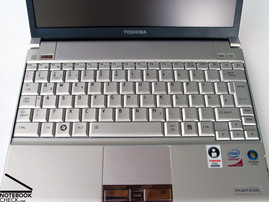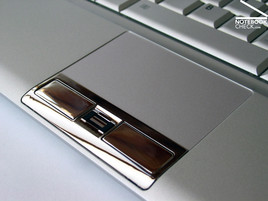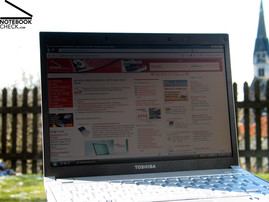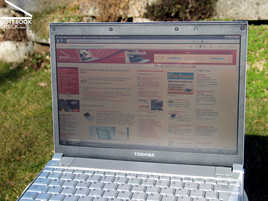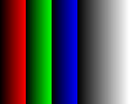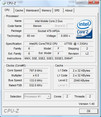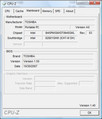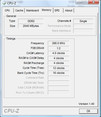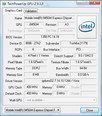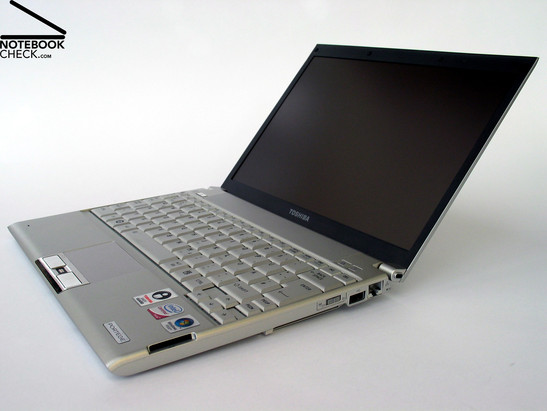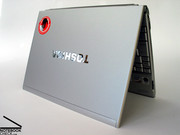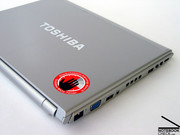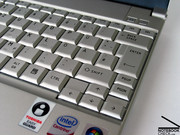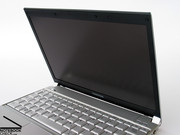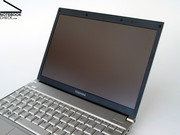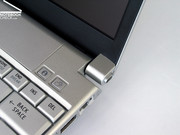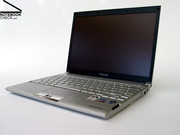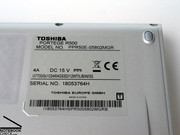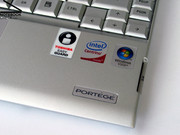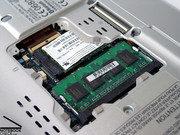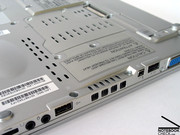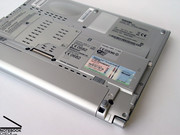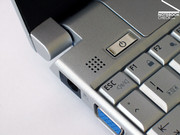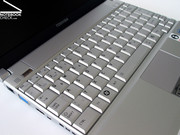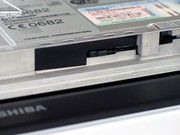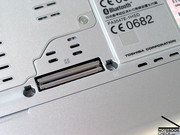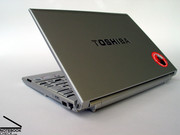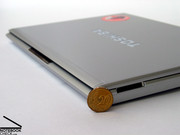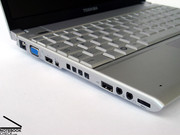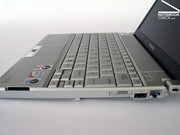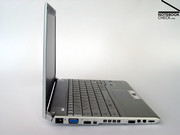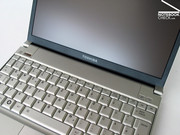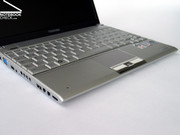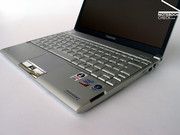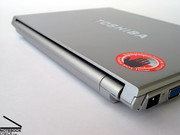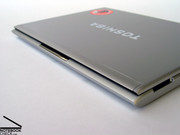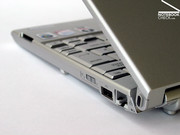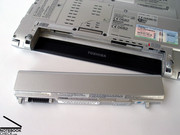Review Toshiba Portégé R500 Subnotebook
First Class Travelling.
The Portégé R500 can be called a prototype of Toshiba's product range. Not only the very interesting equipment - Core 2 Duo U7700 CPU, transreflective LED display, 64 Gigabyte solid state disk, and 3G/UMTS module - hints on this. Furthermore, it is only 810g (!!) light and costs as much as 2,500.- Euro.
Case
Once it is out of the box, first thing that attracts attention is the low weight of the Portégé R500. After a short look to confirm that the battery is already in its place, a total weight of only 810 g is proved. If you use the notebook in a mobile way only 420 g for the power supply, which is about half the weight of the total notebook, have to be added.
How could Toshiba go that clearly below the magic limit of 1kg? This was only possible by continuously reducing weight wherever possible, e.g., at the case. The only material used for the case, which is on the one had a cover, and on the other hand stabilizes the notebook, is magnesium. This way, also the ultra-slim display (4-6mm height) with LED technology is sufficiently stable.
The mass storage device is a solid state drive, which is not only lighter than standard hard disks, but also has some other advantages. Also the battery, which has a capacity of 2900 mAh and only a low number of cells, contributed to saving weight.
The 12.1 inch format of the display appears to be rather spacious regarding the weight aspect. Actually, the R500's case size is well user-friendly. This has also a positive impact on the input devices. Nonetheless, it is still sufficiently compact for being carried around in every bag or suitcase.
The metallic silver surface with due to magnesium brilliant haptics is the most obvious design aspect of the case. Handling the notebook, we, nevertheless, had the impression that the stability is too low, because it is very light and because it sounds amphoric, if you touch the surfaces. Although the passable solidity of the case puts this into perspective, the first impression is persistent.
The display is attached via sufficiently big hinges, which can easily support the slim LED panel. The opening angle can be adjusted with a fingertip. Nevertheless, every position is supported without problems and with only a slight see-saw after adjustment.
Alike other subnotebooks also the Toshiba Portégé R500 does not have a transport hook. This improves without doubt the look, a transport hook would be advantageous though. So, you have to take care that the R500 is protected against object penetration when carrying it. Do not carry it together with loose objects, e.g., pens, which could penetrate in between display and keyboard in order to avoid damaging it. We recommend using a separate cover. Unfortunately such is not provided too.
Interface Equipment
The R500 itself only provides a standard set of interfaces for mobile operation. It consists of three USB ports, Firewire, a VGA Port for connection of an external screen or video projector, headphone and microphone port and a LAN interface at the right side near the back. The Kensington lock is next to the hinge of the display.
Furthermore, the Portégé R500 is equipped with a SD card reader and a PCCard Type II slot at the right side of the case. In order to keep the notebook thin, a built-in optical drive is not available. External DVD solutions are offered by Toshiba as optional accessory for a surcharge of 300,- Euro and more.
A docking solution is indeed important for a mobile subnotebook. So, it's no surprise that also the R500 is equipped with a docking port. It makes it possible to dock the R500 to, e.g., the 'Slim Port Replicator II' by Toshiba, which enhances the available interfaces by four further USB ports, a VGA, and a DVI port, and a LAN port. This docking station costs about 250,- Euro.
Data communication is possible via R500 Gigabit LAN (10BASE-T/100BASE-TX/1000BASE-T) and Wireless LAN Draft-N (Intel 4965AGN). Furthermore, the Portégé R500 is equipped with Bluetooth and an UMTS/HSDPA module, which makes wireless broadband access to the Internet possible, provided you have an according contract with a mobile telephone system service provider. Now, the communication aspect is nearly completely covered. Video telephony also gets more and more important and is nowadays due to good wireless transfer rates, also as mobile solution more and more reasonable. However, the Toshiba Portégé R500 is not equipped with a web cam. Although external solutions are available, a built-in web cam would be handier for mobile use.
A number of components support data security. First of all a fingerprint reader is available, which on the one hand makes access control by the notebook itself possible, and on the other hand easies keying in passwords.
Toshiba's security assistant makes it possible to set a number of passwords(BIOS, Festplatte), to activate the TPM chip, or to set up authentication and sign in via cellular called 'Wireless Key Logon'.
The Bios timer by Toshiba is another anti-theft protection. It requires to periodically key-in a password. A red sticker on the lid should also inform about this feature and warn potential thieves off ...
The solid state drive is in general not shock sensible. Also the notebook model with standard hard disk helps protecting your data by a shock sensor, which is able to detect shocks along all three axis and remove the head in case. So, both versions should be fit for mobile use regarding this aspect.
The scope of delivery only consists of a manual, a Recovery DVD, and a microfibre towel for cleaning the display. Other accessories, like provided by other notebooks, are missing.
Input Devices
Besides a small margin left and right beside the keyboard, Toshiba utilizes the complete available case width and provides a spacious keyboards for the Portégé R500. The total width of the keyboard is 27.7 cm, and the size of the key heads is user-friendly (1.8cm x 1.6cm). So, the R500 is ready for extensive typing.
The keyboard layout follows the usual standard. It's easy to hit all keys without troubles from the very beginning. The size of the keys is overall good. The Enter key extends over two rows and also the space bar has a comfortable size. The F-keys and the cursor keys are clearly smaller. Because they are moved a little bit to the front and are a little bit separated, they are user-friendly too.
Typing is characterized by an early and clear feedback, an ideal key travel and a soft stop at the end. Partly the keyboard yields a little bit under pressure, but, so little, that it does not cause problems. On the contrary, it contributes to soft and user-friendly typing. The noise emissions caused by typing range from quietly clicking to somewhat clattering, if you type more forcefully.
There are only two hot keys besides the standard keyboard. One launches the Toshiba Assist software, which supports communication and security issues. The second one deactivates the backlight of the display, so, that the display is only passively lid by the brightness of the environment.
Once again volume control is, typical Toshiba, user-friendly realized by a turn-switch at the left side near the front. We were also pleased by the hardware switch which controls the WLAN module at the right edge.
The touch pad is due to its big size of 7.1cm x 4.2cm user-riendly. However, you have to consider that about 7-8 mm at the front and bottom margin are reserved for scrolling, whereas the scroll area is not especially marked. The pad is very sensible. On the one hand the mouse pointer could be precisely moved, but, on the other hand we clicked unintentionally many times. This is especially annoying, if you browse the Internet.
Both of the touch pad buttons look very good. In practice it turned out that there is a relatively big area where it does not react at the left and the right of each button. The feedback is only clear, if you click both buttons exactly in their centre. Indeed a notebook of this price category should avoid such flaws.
The built-in display is a special technical highlight. The Toshiba Portégé R500 is equipped with a 12.1 inch transreflective LED display with a resolution of 1280x800 pixels (WXGA). This technology utilizes the brightness of the environment in addition to a LED backlight. So, it is especially advantageous in bright environments, e.g., outdoors. When working in the sunshine the very bright environment contributes to the brightness of the display.
The disadvantages of transreflective displays are usually an only moderate illumination, below-average contrast and subjectively less vivid colours. These can be more or less proved during our review of the Portégé R500.
| |||||||||||||||||||||||||
Brightness Distribution: 90 %
Contrast: 78:1 (Black: 1.98 cd/m²)
The measured maximum brightness of the display in moderate bright environments (e.g., in offices) is 158.2 cd/m². Although the brightness diminishes down to 142.7 cd/m² at the left display edge the illumination of 90.2% is still good. The average brightness of 150.3 cd/m² is also alright.
Because of the relatively high black value of 1.98 cd/m² the maximum contrast is only 80:1 indoors. Also subjectively the picture appears to be blurred and very dependent on the viewing angle.
The real advantage of the used technology gets only obvious outdoors. Due to a matte display surface there aren't heavy reflections and despite a maximum brightness of only 150 cd/m² the display appears to be sufficiently bright. If you deactivate the backlight by the hot key, which would lead to a very dark and hardly legible display indoors, the display stays well legible, if the environment is bright enough. This works at its best in the direct sunshine.
Unfortunately, this LED display cannot convince regarding viewing angles. The best results can be observed directly at the vertical axis. If you are directly above the centre of the display the edges of the display seem to be already slightly blurred.
If the viewing angles deviate from the ideal either horizontally or vertically and at acuter angles, you'll quickly observe an increasing contrast loss, which worsens the quality of the picture.
Video of Display's Viewing Angles
Performance
The main field of operation of the Toshiba Portégé R500 are typical office tasks whose demands on the system aren't too high in general. In order to provide sufficient reserve capacities and at the same time contribute to the high demands on mobility on compact 12 inch subnotebooks, Toshiba equipped the R500 with a U7700 Core 2 Duo CPU. This ULV (Ultra Low Voltage) processor runs at a clock rate of 1.33 GHz and is equipped with 2MB L2-Cache. Furthermore, it utilizes special energy saving mechanisms.
An integrated Intel GMA 950 video chip, which uses up to 256 MB memory of the available RAM (if the notebook is equipped with 2GB RAM) is responsible for graphics. Although this video solution supports only DirectX9.0, it can still represent the Aero desktop of Windows Vista. This solution is also sufficient for other office tasks.
The results of the 3DMark and PCMark benchmark are in comparison average. Although the differ in detail, there aren't any restrictions to expect in practice. The Portégé R500 is guaranteed to run smoothly within its intended fields of operation (Office, Internet, Mail).
Two GB RAM (PC5300 667MHz), whereas 1GB cannot be exchanged by the user, because they are directly on the main board and another 1GB memory module inside the appropriate slot, contribute to the performance. However, 2GB are also the upper limit of RAM, which the R500 can support. According to Toshiba a further upgrade is not possible.
You can choose between two models of the R500. One of them is equipped with a standard 160 GB hard disk and a DVD drive. The reviewed model came without optical drive and a solid state drive. The capacity of the solid state drive is currently only 64 GB. In turn is runs silently and its access times of less than one millisecond are brilliant.
| 3DMark 2001SE Standard | 3233 points | |
| 3DMark 03 Standard | 841 points | |
| 3DMark 05 Standard | 394 points | |
| 3DMark 06 1024x768 Score | 151 points | |
Help | ||
| PCMark 05 Standard | 2460 points | |
Help | ||
| Cinebench R10 | |||
| Settings | Value | ||
| Shading 32Bit | 443 Points | ||
| Rendering Multiple CPUs 32Bit | 2515 Points | ||
| Rendering Single 32Bit | 1335 Points | ||
Emissions
Loudness
In idle mode the fan runs all the time. It's activated a short time after power on and causes noise emissions of 34.5 dB. The noise can be characterized as clearly audible, but acceptable. An optical drive and a standard hard disks are not available, so, these cannot increase the noise.
Even if you only copy data, or install software, the noise of the fan might be increased. However, 36.8 dB are also alright.
With permanent load the noise level increases to up to 41.0 dB, which is surely annoying, if you have to stand it for a longer time. However, in practice the noise emissions should be alright.
Noise level
| Idle |
| 34.5 / 34.5 / 36.8 dB(A) |
| HDD |
| 34.5 dB(A) |
| Load |
| 36.8 / 41 dB(A) |
 | ||
30 dB silent 40 dB(A) audible 50 dB(A) loud |
||
min: | ||
Temperature
Especially at the left side of the case, next to the fan, you can clearly feel that the temperature increases. At this part the measured maximum temperature is 38.1 °C at the top side and 42.3 °C at the bottom side of the case. Both values are alright, although you can clearly feel that the notebook gets warmer if you work lap top.
(+) The maximum temperature on the upper side is 38.1 °C / 101 F, compared to the average of 35.9 °C / 97 F, ranging from 21.4 to 59 °C for the class Subnotebook.
(±) The bottom heats up to a maximum of 42.3 °C / 108 F, compared to the average of 39.3 °C / 103 F
(+) The palmrests and touchpad are reaching skin temperature as a maximum (34.9 °C / 94.8 F) and are therefore not hot.
(-) The average temperature of the palmrest area of similar devices was 28.2 °C / 82.8 F (-6.7 °C / -12 F).
Speakers
The built-in speaker, located left above the keyboard, does not sound very good and it's mono sound is hardly fit for listening to music. It's basically intended for Windows sounds. We definitely recommend to use headphones in order to enjoy music.
Battery Runtime
The Toshiba Portégé R500 is equipped with a lithium ions battery with a capacity of 2900 mAh (31.1 Wh). Running the BatteryEater Classic test the runtime was 68 minutes. This, is the minimum runtime of this notebook under load. Running the Readers test (minimum brightness, WLAN off, energy saving on) the runtime of the R500 was 212 minutes, this is about 3.5 hours possible maximum runtime.
We also did two further tests. With WLAN operation (energy saving on, maximum brightness, WLAN on) the runtime was 153 minutes. Watching DVDs from the solid state drive the runtime of the Portégé R500 was 137 minutes.
To summarize, the battery runtime is moderate. Therefore, Toshiba also offers a clearly bigger battery (5800 mAh), which should be able to clearly increase the battery runtime. If you are going to work a lot in a mobile way, you should definitely upgrade to the bigger battery, but, of course this also increases the total weight of this notebook.
| Off / Standby | |
| Idle | |
| Load |
|
Key:
min: | |
Verdict
Because of advanced notices and the price of the Toshiba Portégés R500 our expectations were high before the review. Testing the Macbook Air, which sets new standards regarding design and workmanship, in parallel, also increased our expectations. Although some aspects should be improved, the Portégé R500 mostly satisfied our expectations.
The design of the case is timeless and elegant and contributes to the good look of the magnesium case. Although the low weight of only 810g lets this notebook appaer to be fragile, the stability of the case is in general alright.
Among others the Toshiba R500 is equipped with a total of three USB ports, and a docking port which makes it possible to enhance the interface equipment in the office. Being generously equipped with communication modules like Gigabit LAN, Wireless LAN Draft-n, Bluetooth, and UMTS/HSDPA is also a pro.
The keyboard convinced by a good key size, a clear keyboard layout, and user-friendly typing. To summarize, it is ready for extensive typing. However, the touch pad, especially its buttons, could not convince. A big part of the buttons does not react upon clicking.
The display's strength is most obvious during outdoor operation in bright environments. The transreflective LED display in 12 inch format utilizes the brightness of the environment and increases its rather moderate average brightness of 150 cd/m², measured indoors, in this way. Weaknesses of this display are its moderate picture representation and contrast and also its limited viewing angles.
Regarding performance the R500 is equipped with components optimized for low energy demands, which are, nevertheless sufficient for standard office work, even more because it comes with a 2GB of RAM and a 64GB SSD.
The emissions are overall alright, but, even in idle mode without load you need to stand a permanently running fan, which is clearly audible.
The measured battery runtime ranges from slightly above one hour under load to a maximum of 3.5 hours with settings optimized for energy saving. In practice, i.e., WLAN operation, the expected runtime is about 2.5 hours. Especially, because the R500 is a mobile and light subnotebook, the battery runtime should be better. We recommend to upgrade to the optionally available bigger battery.









